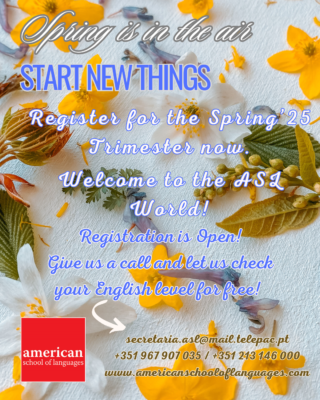


Informações e marcações de testes:
secretaria.asl@mail.telepac.pt / +351 967 907 035

Informações e marcações de testes:
secretaria.asl@mail.telepac.pt / +351 967 907 035
Informações e marcações de testes:
secretaria.asl@mail.telepac.pt / +351 967 907 035

Há +50 anos ao teu lado, a ajudar-te a cumprir os teus objetivos e a alcançar os teus sonhos.
Porque, só é uma aventura impossível aquela que nunca se começa!

Google Business – vista geral de IA sobre a American School of Languages Não podíamos estar mais orgulhosos como instituição.
É para vós, alunos, que professores e pessoal administrativo faz o seu melhor todos os dias. Gratos pela vossa preferência!

Já sabes qual é o melhor segredo do Mundo?! Se ainda não sabes, a American School of Languages está a um click de distância 😉 Contacta-nos já – inscrições abertas para os cursos intensivos de verão (Julho, Agosto e Setembro). Temos aulas online de inglês e/ou espanhol para adultos, jovens ou crianças, sempre acompanhadas por professores nativos especializados em grupo ou individuais. Condições especiais para protocolos (ver página disponível no nosso website) Contacta-nos já para marcar o teste de aferição de conhecimentos!
Inscrições abertas – Marca já o teu teste de aferição gratuito!

Não sofras de nenhum apagão quando tiveres de comunicar em Inglês ou em Espanhol!
Marca já o teu teste de aferição de conhecimentos gratuito connosco.
Coffe & Conversation Classes: aulas de Grupo Fantásticas para desenvolver a fluência e correção. Liga já para marcar o teu teste de aferição de conhecimentos.
A American School of Languages deseja uma Boa Páscoa a todos os seus alunos, staff, família, amigos, bem como aos colaboradores/associados das instituições que ao longo destes anos têm confiado em nós para a sua formação em Inglês e Português como 2ª língua – e, agora também em Espanhol!

Bem-vinda, Primavera’25!
A primavera é a estação do ano que se segue o inverno e precede o verão e é tipicamente associada ao reflorescimento da flora terrestre.
Do ponto de vista da astronomia, a primavera do Hemisfério Sul inicia-se no equinócio de setembro e termina no solstício de dezembro e a do Hemisfério Norte inicia-se no equinócio de março e termina no solstício de junho. A estação, assim como as demais, não ocorre simultaneamente nos dois hemisférios: enquanto num deles é primavera, no outro é outono.[1]
A primavera do hemisfério norte é chamada de “primavera boreal” e a do hemisfério sul é chamada de “primavera austral”.
A palavra deriva do latim, primo vere, que significa “primeiro verão”.
A “primavera boreal” tem início em 20 de março e termina em 21 de junho, podendo estas datas variar um pouco a cada ano.
A estação é característica na maioria dos países deste hemisfério, aqueles mais distantes da Linha do Equador e com as quatro estações bem definidas, tanto nos localizados mais ao norte, como a Rússia, quanto os localizados mais ao sul, como o Japão, onde no início da primavera ocorrem os tradicionais festivais populares para observar a floração das cerejeiras (sakura em japonês).
Nesta região, por ser maior a parte continental, as temperaturas costumam aumentar mais rapidamente do que na primavera do Hemisfério Sul.
Happy Saint Patrick’s Day! March 17th

If it’s March, and it’s green, it must be St. Patrick’s Day.
The day honoring the patron saint of Ireland is a global celebration of Irish heritage. And nowhere is that more so than in the United States, where parades take place in cities around the country and all kinds of foods and drinks are given an emerald hue.
In fact, it was among Irish American communities that the day became the celebration it is, from its roots as a more solemn day with a religious observance in Ireland.
But even in America, it was about more than a chance to dye a river green (looking at you, Chicago) or just bust out a favorite piece of green clothing, it was about putting down roots and claiming a piece of the country’s calendar.W
Who is St. Patrick and why does he even have a day?
Patrick was not actually Irish, according to experts. Born in the late fourth century, he was captured as an adolescent and ended up enslaved in Ireland. He escaped to another part of Europe where he was trained as a priest and returned to Ireland in the fifth century to promote the spread of Christianity.
Tradition holds that he died on 17 March and was buried at Downpatrick. Over the following centuries, many legends grew up around Patrick and he became Ireland’s foremost saint.
Celebrations generally involve public parades and festivals, Irish traditional music sessions (céilithe), and the wearing of green attire or shamrocks.
Trimestre de Primavera’25 – Inscrições Abertas!










Welcome to the Student’s Corner! This is the place you can find resources, read texts submitted by our students, watch videos, and more. Stay tuned as this resource page grows and keep us posted if there’s something you’d like to add. We are all ears.
Here are a few recent videos from our YouTube Channel. Click here to see what else we’re working on and to subscribe for more practice at home!
[blog_posts style=”normal” columns=”3″ columns__md=”1″ image_height=”56.25%”]
Below you’ll find some student compositions regarding the COVID-19 outbreak with a wide range of opinions on the drawbacks and benefits of such a destructive virus.
The Controversial Approach of Swedish Authorities to the COVID-19 Outbreak
by Susana Gonçalves
It seems clear that, by avoiding the lockdown, the Swedish authorities are not implementing measures in line with the ones most of the remaining governments have implemented and, especially, they are not aligned with the World Health Organisation recommendations.
Apparently, against all recommendations and international policies, Sweden is testing a theory of immunity. However, shouldn’t we ask if people’s lives are not more important than any experiment? In my view, it is a high-risk experiment that, ultimately, can put thousands of human lives at risk.
Even considering the typical social distance that we can find in Nordic countries and their strong healthcare systems, in my opinion, no one can ensure that the Swedish healthcare system will not fail and when the relevant authorities realise this, it may be too late.
Despite any conspiracy theories, in my opinion, the current lack of measures to fight the pandemic is more based on economic reasons than any other reason. There have been far too many examples of tragedies deriving from COVID-19 (in some nearby countries, such as Italy) that it is impossible to believe that Swedish authorities are not taking that scenario into consideration.
Having said all this, I hope that Sweden proves that we are all wrong and that the immunity theory really works. Indeed, it would be a simpler way to deal with this virus (and also the less aggressive way from an economic perspective).
What Should We Do to Return to Some Sort of Normality?
by Mabel
If someone told us only a few months ago that we had to keep a relatively safe distance from other people, stay at home, and wear masks and gloves every time we need to go to the grocery store, we certainly wouldn`t believe it.
These are strange days. We almost feel like characters from a science-fiction (or si-fi) movie.
We all had to change our habits and had to learn to live in a different way. All this is due to the pandemic of the “Corona virus” that has spread all over the world.
Almost two months have passed from the implementation of the first measures of confinement and now the time has come for some countries to begin reopening the economy and return to some sort of normality.
Gradually, people will return to their previous lives.
However, this will take some time. We will all still have to follow some rules for a long time to guarantee that we stay safe and that we don`t put others at risk (in danger).
In conclusion, we can say that in spite of the reopening of the economy, and the beginning of some activities, it will take some time for people to feel as free as they were before.
In my opinion, this lack of freedom is the most difficult to deal with and that’s the worst part of it all.

Untitled
by Luna Franceschelli
These last few weeks have been tough for everyone. We’re now facing an extraordinary event, which none of us has ever lived before. Since I’ve been working from home for a very long time now, I can’t say my life has drastically changed, but not being able to live my regular outdoor life is not easy.
I’ve been spending most of my day working – as before – but I’ve now got more time to spend doing things I couldn’t do a month ago. I’ve been attending some very interesting webinars and on-line courses, I’ve been watching several movies and TV shows (as everyone out there), and most important I’ve been talking to my family and friends as never before.
At the moment, the hardest part for me is not being able to travel or plan any trips in the near future. I often think of a place I would like to be or to go, and then I remember that it could be impossible for quite a long time. That hurts! 😀
I’m not complaining though: I’m safe and sound, my family and friends are fine, and when it’s sunny outside my bedroom gets direct sunlight all day long. I just need an inflatable pool and I’m all set for the summer.
What Can We Learn and How Can We Benefit From This Situation?
by Ana Paula Dias Rodrigues
The virus led us to isolation, and this led us to relearn new ways of being in life, such as living more permanently at home. People have been able to learn new ways of working, either because they had to change their activity, or because they adapted to working from home. So, they have more time with their family, and the parents can enjoy more time with their children. Parents now have more time to help teach their children at home.
Also, with more time at home, many people are developing new activities, hobbies, and tasks, which in their previous normal routine they would not have time for, such as reading, playing, exercising, writing, doing DIY tasks, and more.
Despite the negative effects of the pandemic, people are trying to manage to overcome what is bad, and are looking more at the benefits.

